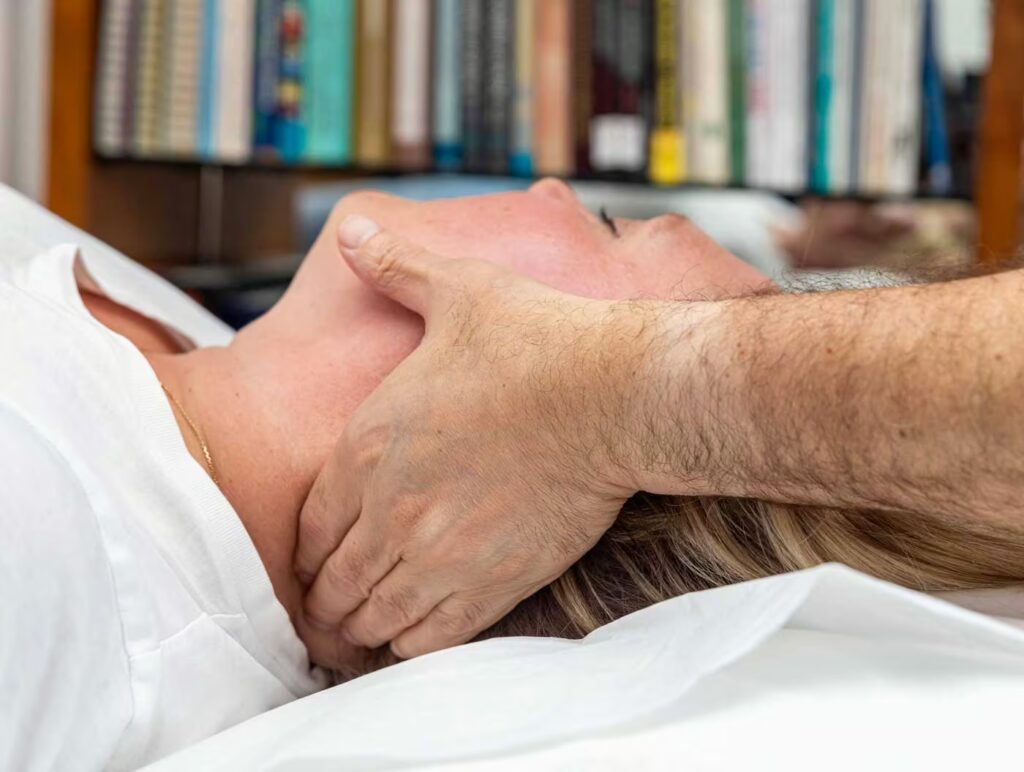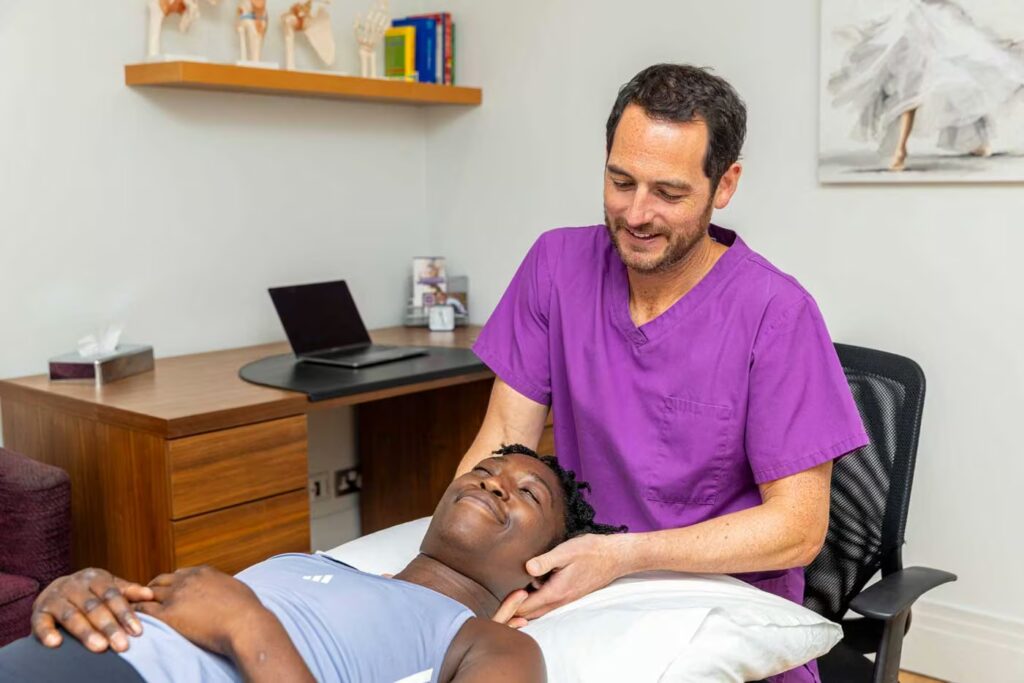
Treatments
Cranial Osteopathy
Cranial osteopathy is an extension of osteopathy that focuses on releasing tension and restoring balance in the body, underpinned by the study of anatomy, physiology, neurology, and embryology.
Despite its name, cranial osteopaths take a holistic, whole-body approach and aim their treatment at harmonising the body’s structure to allow it to function at its best. They assess how the body functions as a unit and aim to make tiny interventions using gentle and light pressure to release tension and restore balance.
Cranial osteopathy is:
- Focused on releasing tension and restoring balance
- Gentle, non-invasive, and subtle
- Calming and restorative
Our cranial osteopaths have extensive training across a variety of patients, from newborns to those later in life. Because the treatment associated with cranial osteopathy is gentle, it’s ideal for frail or infirm patients who might feel uncomfortable with more direct treatments.
Why choose our Leeds cranial osteopathy clinic?
- Fully qualified, General Osteopathic Council (GOsC)-registered osteopaths
- Multi-disciplinary team offering integrated care with complementary therapies
- Over three decades of experience at our Leeds-based clinic
- Welcoming and accessible facilities with private treatment rooms
- Appointments available weekdays and Saturdays
- Trusted by local residents, families, and professionals since 1993

Meet our qualified osteopaths
Cranial Osteopathy FAQs
What is cranial osteopathy?
Cranial osteopathy is a technique used by trained osteopaths to help people of all ages.
It’s a very gentle treatment. The osteopath uses their highly developed sense of touch to detect and alleviate areas of strain, both at the head and throughout the body.
Because it’s so gentle, it’s a safe method of treating people who are more vulnerable. That might be babies, the very elderly, or those who have significant injuries or trauma.
How does cranial osteopathy work?
Cranial osteopathy works by gently easing areas of strain or restriction in the body to enhance function and overall health.
Osteopaths often work at the head. They use their knowledge of the bones of the skull, the connective tissues and other anatomy to build up a 3D picture. Sensing the movement in this anatomy gives them information about how well the different areas of the body are working in unison.
They can then direct a subtle pressure to help release areas that are not working at full capacity. This release can allow that part to re-integrate with the rest of the body, meaning cranial osteopathy can have far-reaching benefits for health.
You could liken it to re-tuning an instrument in an orchestra, allowing full harmony to return.
What does a cranial osteopath do?
A cranial osteopath treats holistically. They ease restrictions or dysfunctions wherever they find them. They seek to enhance the health and function of the whole body.
Cranial osteopaths learn how to listen to the body with their hands. This heightened sense of touch, or ‘palpation’, enables them to feel the natural rhythms that occur in our bodies. They focus on the quality of these rhythms to understand whether the body is functioning healthily, and how well the different parts integrate and contribute to the whole.
When an osteopath detects areas that feel strained or restricted, they use a very subtle pressure to encourage a return to full and free function.
Is cranial osteopathy just for babies?
Cranial osteopathy is often associated with babies. That’s because many parents and carers have found it to be enormously beneficial in comforting and relaxing babies. In fact, our osteopaths often find that distressed babies calm down and even fall asleep during a session!
But cranial osteopathy isn’t just for babies. A treatment that’s safe, gentle and effective for babies is just as helpful for people of all ages. An osteopath may suggest cranial osteopathy treatment to a patient if they feel it would be particularly suitable for them. For example, the patient may be frail, or have injuries or conditions that mean other treatment techniques may be inappropriate.
Some patients may request cranial osteopathy as a treatment of choice. They may find it particularly effective, and many people enjoy the sense of warmth and relaxation that it can give.
Can children benefit from cranial osteopathy?
Yes, cranial osteopathy is well-suited to children, including babies and infants, older children and teenagers.
Young children may not be able to say where they have pain and discomfort. A cranial osteopath uses touch to evaluate the body and may be able to discover problems that the child is unable to express.
And many children like the very gentle approach that cranial osteopathy brings. They may feel more comfortable with the light touch and subtlety that it offers.
What training do cranial osteopaths undergo?
Osteopaths learn about cranial osteopathy as part of their undergraduate degree course. But many will go on to do further training in cranial osteopathy after they have graduated.
There are institutions that offer specific training in cranial osteopathy to qualified osteopaths, including the Sutherland Cranial College and the Osteopathic Centre for Children. Several of our osteopaths have postgraduate qualifications in cranial osteopathic technique.
If you’d like to know more about our osteopaths’ training and qualifications, feel free to get in touch.
What can cranial osteopathy help with?
Cranial osteopaths, like any osteopaths, treat people rather than conditions.
Cranial osteopathy can be seen as a way of assessing the healthy functioning of a person’s body, and of treating areas of poor function.
Osteopaths recognise the body’s own ability to heal and restore itself, and the aim of cranial osteopathy is to remove blocks to healthy function. That way, the body can establish full health again.
Cranial osteopathy is effective at relieving tensions and strains throughout the body, reducing discomfort and aiding relaxation. It’s a wonderful way to treat people of all types and ages, including adults and the elderly, pregnant women, young people, children and babies.
What happens during cranial osteopathy?
Seeing a cranial osteopath is like seeing any other osteopath. They will ask about your symptoms, your medical history and your lifestyle. They may do other tests, such as examining your movement or flexibility, or testing your reflexes, nerve function or blood pressure.
Although cranial osteopathy is just one of many osteopathic techniques, it may look and feel different to others. For example, you can usually be assessed and treated while remaining fully clothed. The osteopath places their hands very lightly on your head, at the base of your back, or on another part of your body. They may sit quietly for some time, while they concentrate on feeling the rhythms and tensions of the body to build up a picture of how you’re functioning.
Assessment and diagnosis often flow into treatment. The osteopath adjusts their touch to treat areas of restriction as they find them.
As always, the osteopath will make sure you understand what they’re going to do and that you’re happy before starting treatment. And if you have any questions, just ask!
Does cranial osteopathy work?
As far as scientific evidence goes, at the moment, the jury’s out. This is largely because scientific research studies are difficult and expensive to carry out.
However, promising evidence that supports the use of cranial osteopathy is building. For example, the rhythms that cranial osteopaths have long stated they can feel have now been measured by instrumentation. And there’s a growing number of studies demonstrating that cranial treatment can reduce the length of time newborn babies need to stay in hospital.
But most evidence is still anecdotal – it comes from the thousands of people who have cranial osteopathy every year. Here are a few things people have said about our treatment:
“My baby has made great progress and his neck muscles are a lot less tense. He has a better range of motion and his reflux symptoms have pretty much gone now!”
“After just one session we saw such a huge improvement, our baby felt so much more relaxed.”
“Went in as a sceptic but was quickly a convert.
Cranial osteopathy works.”
